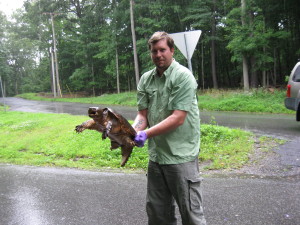TURTLE REMOVAL WESTCHESTER, NY
Call 914-293-7593 For 24/7 Emergency NY Wildlife Removal and Prevention
Turtle Biology:
Common Snapping Turtle (Chelydra serpentina)

The most common turtle Intrepid runs into is the snapping turtle. Snapping turtles can range in size from 9.8 to 18.5 inches. They weigh between 9.9 and 35.3 pounds, they can live up to 30 years in the wild. Typically snapping turtle diet consists of plants. They also eat fish, snakes, smaller turtles, reptiles, invertebrates, and even small birds. These turtles can often be found in shallow streams, ponds or lakes. In these environments they will lay at the bottom and raise their head up for air. Usually when people encounter turtles, it’s on land. The reason for snapping turtles found outside of water is because they will travel long stretches to reach a new location to lay eggs or find a new habitat. Their reproductive season lasts from April to November with a peak point in June and July.
Turtle Damage:
The only damage from snapping turtles are seen at stocked fish ponds and commercial hatcheries and occasionally duck ponds. The turtles will enter the pond and eat the small fish and even the small ducks.
Heath Concerns:
The most obvious danger to people is found right in their name. Snapping Turtles snap is because they are incapable of retreating into their shell, rather they snap as their primary defense. Usually these turtles will retreat from a confrontation in both water and on land.
Turtle Removal:
There are circumstances where Snapping Turtles will enter swimming pools or Coy pond on a client’s property and will be unable to get out. A trained technician will arrive and move the turtle to the edge of pool or pond by net then carefully grab it by hand and remove it. After the turtle will be released in a nearby waterway safely away from homes.
On occasion Intrepid has received calls of snapping turtles being seen on the edge of a property remaining stationary for a long period. This is usually an indicator of a female laying eggs. We recommend not to approach or disturb and just let nature take its course. Eventually the turtle will leave. Once the turtle is gone try and leave the area undisturbed as any touch from a human will leave a scent that can attract raccoons which will make a meal out of the eggs. As rare as it may be, you may be fortunate enough to see the migration of hatchlings, please do not attempt to rescue them.
Turtle Prevention:
Establish a fence or barrier around any waterways such as pools, ponds, or any body of water on your property to prevent the turtles access.
